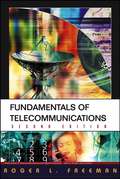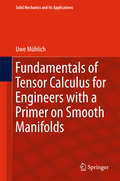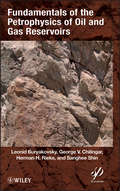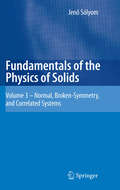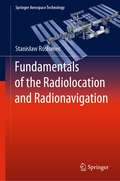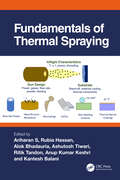- Table View
- List View
Fundamentals of Sustainable Drilling Engineering (Wiley-Scrivener)
by M. E. Hossain Abdulaziz Abdullah Al-MajedThe book clearly explains the concepts of the drilling engineering and presents the existing knowledge ranging from the history of drilling technology to well completion. This textbook takes on the difficult issue of sustainability in drilling engineering and tries to present the engineering terminologies in a clear manner so that the new hire, as well as the veteran driller, will be able to understand the drilling concepts with minimum effort. This textbook is an excellent resource for petroleum engineering students, drilling engineers, supervisors & managers, researchers and environmental engineers for planning every aspect of rig operations in the most sustainable, environmentally responsible manner, using the most up-to-date technological advancements in equipment and processes.
Fundamentals of Sustainable Neighbourhoods
by Avi FriedmanThis timely book introduces architects, engineers, builders, and urban planners to a range of contemporary community design concepts and illustrates them with outstanding case studies from around the world. Drawing on successful projects from London, New Mexico, Austria, and the Netherlands, "Innovative Sustainable Communities" presents planning concepts that minimize developments' carbon footprint through compact communities, adaptable and expandable dwellings, edible landscape, and smaller-sized yet quality designed housing.
Fundamentals of Sustainable Urban Design
by Avi FriedmanThis book begins with an introduction describing current societal transformations that merit new urban designs, including depletion of non-renewable natural resources, elevated levels of greenhouse gas emissions, large numbers of aging “Baby Boomers,” and climate change. Dr. Friedman then examines these challenges through thirty chapters of interest to urban designers, architects, civil and construction engineers, and town planners. Each of these topics represents an aspect of urban design and describes an innovative solution and offers a detailed description of underlying principles. The highly illustrated text presents innovative urban design strategies based on sustainable principles. Integrated with each chapter are several international case studies illustrating design implementations.
Fundamentals of Sustainable Urban Renewal in Small and Mid-Sized Towns
by Avi FriedmanThe book introduces challenges affecting smaller urban communities with fewer than 50,000 inhabitants and offers urban planning and building/architectural strategies to strengthen their city centers. It divides urban renewal of small towns into sub-components such as environmental challenges, demographic trends, economic changes and cultural aspects, and aging infrastructure. In each, context is established, and principles are outlined and illustrated. Topics include urban form, mobility and connectivity, infill neighborhoods design, wealth generation, and promotion of local culture and well‐being. Reinforced with detailed case studies, Fundamentals of Sustainable Urban Renewal in Small and Mid‐Sized Towns is an ideal resource for municipal planners, architects, civil engineers, and policy makers.
Fundamentals of Switching Theory and Logic Design: A Hands on Approach
by Jaakko Astola Radomir S. StankovicFundamentals of Switching Theory and Logic Design discusses the basics of switching theory and logic design from a slightly alternative point of view and also presents links between switching theory and related areas of signal processing and system theory. Switching theory is a branch of applied mathematic providing mathematical foundations for logic design, which can be considered as a part of digital system design concerning realizations of systems whose inputs and outputs are described by logic functions.
Fundamentals of Systems Biology: From Synthetic Circuits to Whole-cell Models
by Markus W. CovertFor decades biology has focused on decoding cellular processes one gene at a time, but many of the most pressing biological questions, as well as diseases such as cancer and heart disease, are related to complex systems involving the interaction of hundreds, or even thousands, of gene products and other factors. How do we begin to understand this complexity? Fundamentals of Systems Biology: From Synthetic Circuits to Whole-cell Models introduces students to methods they can use to tackle complex systems head-on, carefully walking them through studies that comprise the foundation and frontier of systems biology. The first section of the book focuses on bringing students quickly up to speed with a variety of modeling methods in the context of a synthetic biological circuit. This innovative approach builds intuition about the strengths and weaknesses of each method and becomes critical in the book’s second half, where much more complicated network models are addressed—including transcriptional, signaling, metabolic, and even integrated multi-network models. The approach makes the work much more accessible to novices (undergraduates, medical students, and biologists new to mathematical modeling) while still having much to offer experienced modelers--whether their interests are microbes, organs, whole organisms, diseases, synthetic biology, or just about any field that investigates living systems.
Fundamentals of Systems Biology: From Synthetic Circuits to Whole-cell Models
by Markus W. CovertFor decades biology has focused on decoding cellular processes one gene at a time, but many of the most pressing biological questions, as well as diseases such as cancer and heart disease, are related to complex systems involving the interaction of hundreds, or even thousands, of gene products and other factors. How do we begin to understand this complexity? Fundamentals of Systems Biology: From Synthetic Circuits to Whole-cell Models introduces students to methods they can use to tackle complex systems head-on, carefully walking them through studies that comprise the foundation and frontier of systems biology. The first section of the book focuses on bringing students quickly up to speed with a variety of modeling methods in the context of a synthetic biological circuit. This innovative approach builds intuition about the strengths and weaknesses of each method and becomes critical in the book’s second half, where much more complicated network models are addressed—including transcriptional, signaling, metabolic, and even integrated multi-network models. The approach makes the work much more accessible to novices (undergraduates, medical students, and biologists new to mathematical modeling) while still having much to offer experienced modelers--whether their interests are microbes, organs, whole organisms, diseases, synthetic biology, or just about any field that investigates living systems.
Fundamentals of Systems Biology: From Synthetic Circuits to Whole-cell Models
by Markus W. CovertFor decades biology has focused on decoding cellular processes one gene at a time, but many of the most pressing biological questions, as well as diseases such as cancer and heart disease, are related to complex systems involving the interaction of hundreds, or even thousands, of gene products and other factors. How do we begin to understand this complexity? Fundamentals of Systems Biology: From Synthetic Circuits to Whole-cell Models introduces students to methods they can use to tackle complex systems head-on, carefully walking them through studies that comprise the foundation and frontier of systems biology. The first section of the book focuses on bringing students quickly up to speed with a variety of modeling methods in the context of a synthetic biological circuit. This innovative approach builds intuition about the strengths and weaknesses of each method and becomes critical in the book’s second half, where much more complicated network models are addressed—including transcriptional, signaling, metabolic, and even integrated multi-network models. The approach makes the work much more accessible to novices (undergraduates, medical students, and biologists new to mathematical modeling) while still having much to offer experienced modelers--whether their interests are microbes, organs, whole organisms, diseases, synthetic biology, or just about any field that investigates living systems.
Fundamentals of Technical Thermodynamics: Textbook for Engineering Students
by Martin Dehli Ernst Doering Herbert SchedwillThis textbook presents the essential scientific principles of thermodynamics in a detailed and well-structured manner for practice-oriented teaching. It conveys analytically reliable knowledge with a view to engineering application and provides the key to a quick understanding of e.g. thermal machines, heat transfer, humid air and combustion. The present English edition - in comparison to earlier German editions - has been extended to include aspects of fluid mechanics, dynamics of ideal gases and chemical thermodynamics.
Fundamentals of Telecommunications (Wiley Series in Telecommunications and Signal Processing #92)
by Roger L. FreemanThe Second Edition of this critically-acclaimed text continues the standard of excellence set in the first edition by providing a thorough introduction to the fundamentals of telecommunication networks without bogging you down in complex technical jargon or math. Although focusing on the basics, the book has been thoroughly updated with the latest advances in the field, including a new chapter on metropolitan area networks (MANs) and new sections on Mobile Fi, ZigBee and ultrawideband. You’ll learn which choices are now available to an organization, how to evaluate them and how to develop strategies that achieve the best balance among cost, security and performance factors for voice, data, and image communication.
Fundamentals of Tensor Calculus for Engineers with a Primer on Smooth Manifolds (Solid Mechanics and Its Applications #230)
by Uwe MühlichThis book presents the fundamentals of modern tensor calculus for students in engineering and applied physics, emphasizing those aspects that are crucial for applying tensor calculus safely in Euclidian space and for grasping the very essence of the smooth manifold concept.After introducing the subject, it provides a brief exposition on point set topology to familiarize readers with the subject, especially with those topics required in later chapters.It then describes the finite dimensional real vector space and its dual, focusing on the usefulness of the latter for encoding duality concepts in physics. Moreover, it introduces tensors as objects that encode linear mappings and discusses affine and Euclidean spaces. Tensor analysis is explored first in Euclidean space, starting from a generalization of the concept of differentiability and proceeding towards concepts such as directional derivative, covariant derivative and integration based on differential forms. The final chapter addresses the role of smooth manifolds in modeling spaces other than Euclidean space, particularly the concepts of smooth atlas and tangent space, which are crucial to understanding the topic. Two of the most important concepts, namely the tangent bundle and the Lie derivative, are subsequently worked out.
Fundamentals of Terahertz Devices and Applications
by Dimitris PavlidisAn authoritative and comprehensive guide to the devices and applications of Terahertz technology Terahertz (THz) technology relates to applications that span in frequency from a few hundred GHz to more than 1000 GHz. Fundamentals of Terahertz Devices and Applications offers a comprehensive review of the devices and applications of Terahertz technology. With contributions from a range of experts on the topic, this book contains in a single volume an inclusive review of THz devices for signal generation, detection and treatment. Fundamentals of Terahertz Devices and Applications offers an exploration and addresses key categories and aspects of Terahertz Technology such as: sources, detectors, transmission, electronic considerations and applications, optical (photonic) considerations and applications. Worked examples—based on the contributors' extensive experience— highlight the chapter material presented. The text is designed for use by novices and professionals who want a better understanding of device operation and use, and is suitable for instructional purposes This important book: Offers the most relevant up-to-date research information and insight into the future developments in the technology Addresses a wide-range of categories and aspects of Terahertz technology Includes material to support courses on Terahertz Technology and more Contains illustrative worked examples Written for researchers, students, and professional engineers, Fundamentals of Terahertz Devices and Applications offers an in-depth exploration of the topic that is designed for both novices and professionals and can be adopted for instructional purposes.
Fundamentals of Terahertz Devices and Applications
by Dimitris PavlidisAn authoritative and comprehensive guide to the devices and applications of Terahertz technology Terahertz (THz) technology relates to applications that span in frequency from a few hundred GHz to more than 1000 GHz. Fundamentals of Terahertz Devices and Applications offers a comprehensive review of the devices and applications of Terahertz technology. With contributions from a range of experts on the topic, this book contains in a single volume an inclusive review of THz devices for signal generation, detection and treatment. Fundamentals of Terahertz Devices and Applications offers an exploration and addresses key categories and aspects of Terahertz Technology such as: sources, detectors, transmission, electronic considerations and applications, optical (photonic) considerations and applications. Worked examples—based on the contributors' extensive experience— highlight the chapter material presented. The text is designed for use by novices and professionals who want a better understanding of device operation and use, and is suitable for instructional purposes This important book: Offers the most relevant up-to-date research information and insight into the future developments in the technology Addresses a wide-range of categories and aspects of Terahertz technology Includes material to support courses on Terahertz Technology and more Contains illustrative worked examples Written for researchers, students, and professional engineers, Fundamentals of Terahertz Devices and Applications offers an in-depth exploration of the topic that is designed for both novices and professionals and can be adopted for instructional purposes.
Fundamentals of the Fuzzy Logic-Based Generalized Theory of Decisions (Studies in Fuzziness and Soft Computing)
by Rafik Aziz AlievEvery day decision making and decision making in complex human-centric systems are characterized by imperfect decision-relevant information. Main drawback of the existing decision theories is namely incapability to deal with imperfect information and modeling vague preferences. Actually, a paradigm of non-numerical probabilities in decision making has a long history and arose also in Keynes’s analysis of uncertainty. There is a need for further generalization – a move to decision theories with perception-based imperfect information described in NL. The languages of new decision models for human-centric systems should be not languages based on binary logic but human-centric computational schemes able to operate on NL-described information. Development of new theories is now possible due to an increased computational power of information processing systems which allows for computations with imperfect information, particularly, imprecise and partially true information, which are much more complex than computations over numbers and probabilities.The monograph exposes the foundations of a new decision theory with imperfect decision-relevant information on environment and a decision maker’s behavior. This theory is based on the synthesis of the fuzzy sets theory with perception-based information and the probability theory.The book is self containing and represents in a systematic way the decision theory with imperfect information into the educational systems. The book will be helpful for teachers and students of universities and colleges, for managers and specialists from various fields of business and economics, production and social sphere.
Fundamentals of the Optics of Materials: Tutorial and Problem Solving
by Vladimir I. Gavrilenko Volodymyr S. OvechkoThis textbook showcases the rapidly developing field of materials optics. It is aimed at a broad audience as the readers require only university entry level knowledge of physics, chemistry, and optics. It overviews the basics of optical engineering and the typical and widely used applications of materials optics, with the first general chapters corresponding to the standard university courses, targeting bachelor’s and master’s degrees in physics. The next few chapters present the modern developments in materials optics, such as nano-plasmonics, nano-photonics, and optical properties of nano-sized materials, intended for readers familiar with the basic elements of quantum mechanics. Some more specialized chapters address recent developments in fields such as optics of solid surfaces, plasma optics, optics of composites, alloys, and metamaterials; optics of anisotropic materials; optics of organic and biological materials; and relativistic effects in optics. The appendices present a more advanced description of selected topics, with important reference materials, subject index, and extended list of publications, as well as numerous examples and problems to better orient readers interested in gaining further knowledge of the subject.
Fundamentals of the Optics of Materials: Tutorial and Problem Solving
by Vladimir I. Gavrilenko Volodymyr S. OvechkoThis textbook showcases the rapidly developing field of materials optics. It is aimed at a broad audience as the readers require only university entry level knowledge of physics, chemistry, and optics. It overviews the basics of optical engineering and the typical and widely used applications of materials optics, with the first general chapters corresponding to the standard university courses, targeting bachelor’s and master’s degrees in physics. The next few chapters present the modern developments in materials optics, such as nano-plasmonics, nano-photonics, and optical properties of nano-sized materials, intended for readers familiar with the basic elements of quantum mechanics. Some more specialized chapters address recent developments in fields such as optics of solid surfaces, plasma optics, optics of composites, alloys, and metamaterials; optics of anisotropic materials; optics of organic and biological materials; and relativistic effects in optics. The appendices present a more advanced description of selected topics, with important reference materials, subject index, and extended list of publications, as well as numerous examples and problems to better orient readers interested in gaining further knowledge of the subject.
Fundamentals of the Petrophysics of Oil and Gas Reservoirs
by Leonid Buryakovsky G. V. Chilingar Herman H. Rieke Sanghee ShinWritten by some of the world’s most renowned petroleum and environmental engineers, Petrophysics: The Fundamentals of Oil and Gas Revervoirs is the first book to offer the practicing engineer and engineering student these new cutting-edge techniques for prediction and forecasting in petroleum engineering and environmental management.
Fundamentals of the Petrophysics of Oil and Gas Reservoirs
by Leonid Buryakovsky G. V. Chilingar Herman H. Rieke Sanghee ShinWritten by some of the world’s most renowned petroleum and environmental engineers, Petrophysics: The Fundamentals of Oil and Gas Revervoirs is the first book to offer the practicing engineer and engineering student these new cutting-edge techniques for prediction and forecasting in petroleum engineering and environmental management.
Fundamentals of the Physical-Chemistry of Pulverized Coal Combustion (NATO Science Series E: #137)
by L. Lahaye G. PradoThe study of coal for the production of energy is certainly not a new area of research. Many research works were carried out to improve the efficiency of industrial and domestic facilities. In the sixties, however, because of the availability and low cost of petroleum, coal consumption decreased and the research effort in this area was minimum. Meanwhile, the situation has totally changed. Considering the reserves of oil and the instability ofregions where they are located, it is becoming absolutely necessary to develop other sources of energy.The major alternative to oil appears to be coal, at least for the near future. Indeed, the reserves known today represent several centuries of energy consumption.!t is therefore becoming urgent to develop efficient and non polluting technologies to produce energy from coal. The main possibilities are : · liquefaction · gasification · directed combustion. Research and development efforts on liquefaction have been considerably reduced because of high cost of technologies involved and poor prospects for the next two decades. Research works on gasification are progressing; it is a promising approach. However, direct combustion either in pulverized coal furnaces or in fluidized beds is the more promising way of expanding rapidly the utilization of coal. These techniques are already used in some facilities but many environmental problems remain, slowing down their development.
Fundamentals of the Physics of Solids: Volume 3 - Normal, Broken-Symmetry, and Correlated Systems
by Jenö SólyomThis book is the third of a three-volume series written by the same author. It aims to deliver a comprehensive and self-contained account of the fundamentals of the physics of solids. In the presentation of the properties and experimentally observed phenomena together with the basic concepts and theoretical methods, it goes far beyond most classic texts. The essential features of various experimental techniques are also explained. This volume is devoted mostly to the discussion of the effects of electron—electron interaction beyond the one-electron approximation. The density-functional theory is introduced to account for correlation effects. The response to external perturbations is discussed in the framework of linear response theory. Landau’s Fermi-liquid theory is followed by the theory of Luttinger liquids. The subsequent chapters are devoted to electronic phases with broken symmetry: to itinerant magnetism, to spin- and charge-density waves and their realizations in quasi-one-dimensional materials, as well as to the microscopic theory of superconductivity. An overview is given of the physics of strongly correlated systems. The last chapter covers selected problems in the physics of disordered systems.
Fundamentals of the Radiolocation and Radionavigation (Springer Aerospace Technology)
by Stanisław RosłoniecThe book presents principles of operation of radar and radionavigation systems. The group of radar systems includes: primary and secondary radiolocations, bistatic and multistatic systems. They are illustrated with relevant examples of calculation and applications. The issues of increasing the range of the radar systems are presented together with the matched filtering of the used signals. Other discussed issues are methods for eliminating interfering signals and researching methods of 3D space. Various methods of the monopulse radiolocation are presented in Chapter 12. In Chapters 13–18 terrestrial and satellite radionavigation systems are under discussion. The terrestrial systems are: Loran C, Decca Navigator and Omega. The TRANSIT is an example of a hyperbolic satellite system. The stadiometric systems GPS, GLONASS, GALILEO, BeiDou, IRNSS and QZSS are discussed together with differential systems augmentating of them. The ILS, MLS and TLS supporting the landing of aircrafts are discussed in Chapter 17. The prospects for replacing of them with satellite systems augmentated by appropriate reference ground-based stations (GBAS) are also analyzed. Various beacons and ranging devices used in aviation are described in the Chapter 18. This book is intended primarily for students and engineers interested in radar, radionavigation and aerospace engineering.
Fundamentals of the Three-Dimensional Theory of Stability of Deformable Bodies (Foundations of Engineering Mechanics)
by A.N. GuzAt the present time stability theory of deformable systems has been developed into a manifold field within solid mechanics with methods, techniques and approaches of its own. We can hardly name a branch of industry or civil engineering where the results of the stability theory have not found their application. This extensive development together with engineering applications are reflected in a flurry of papers appearing in periodicals as well as in a plenty of monographs, textbooks and reference books. In so doing, overwhelming majority of researchers, con cerned with the problems of practical interest, have dealt with the loss of stability in the thin-walled structural elements. Trying to simplify solution of the problems, they have used two- and one-dimensional theories based on various auxiliary hypotheses. This activity contributed a lot to the preferential development of the stability theory of thin-walled structures and organisation of this theory into a branch of solid mechanics with its own up-to-date methods and trends, but left three-dimensional linearised theory of deformable bodies stability (TL TDBS), methods of solving and solutions of the three-dimensional stability problems themselves almost without attention. It must be emphasised that by three dimensional theories and problems in this book are meant those theories and problems which do not draw two-dimensional plate and shell and one-dimensional rod theories.
Fundamentals of Thermal Radiation for Energy Utilization in Fuel Combustion (Advanced Topics in Science and Technology in China #67)
by Shiquan Shan Zhijun Zhou Yanwei ZhangThis book is in the field of Engineering Thermophysics. It first introduces the authors’ academic thoughts of photo-thermal energy cascade conversion in the fuel combustion. Afterward, a series of thermal radiation theories and models have been developed based on the aim of radiative energy utilization, including spectral radiation available energy theory, gas radiation model under complex combustion conditions, and calculation model of radiation available energy transfer in combustion medium. Based on simulation and experimental results, the radiative energy characteristics of different fuel combustion are introduced. This book develops the radiation theory of the combustion process from a new perspective, integrating theories, models, and experimental results. This book can be used as a reference for scientists, engineers, and graduate students engaged in energy environment, combustion, and thermal radiation.
Fundamentals of Thermal Spraying
by Alok Bhadauria Ashutosh Tiwari Ritik Tandon Anup Kumar Keshri Kantesh Balani Ariharan S Rubia HassanThis book discusses the concepts and uses of thermal spraying including starting powder, spraying parameters, diagnostics, coating deposition, evolved microstructure and resulting properties complemented with several case studies to associate the learnings with applied concepts. The major parts of the instrumentation, the spraying gun, which is the fundamental aspect of different thermal spraying conditions are also discussed. Solved examples, numerical problems and descriptive questions are included for self-assessment at the end of every chapter. The book: Discusses all aspects from starting powder, spraying parameters, diagnostics and coating deposition; Explores schematics to highlight the conceptual notes; Includes multiple case studies from domains including aerospace, biomedical, manufacturing, wettability and others to highlight the practical application of thermally sprayed coatings; Covers classification of thermal spray techniques; and Contains solved example, numerical problems and descriptive questions for self-assessment. This book is aimed at senior undergraduates and graduates in materials science and engineering.







